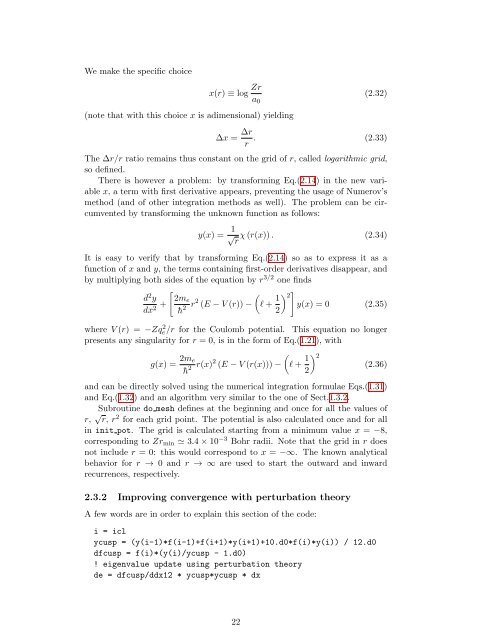Numerical Methods in Quantum Mechanics - Dipartimento di Fisica
Numerical Methods in Quantum Mechanics - Dipartimento di Fisica
Numerical Methods in Quantum Mechanics - Dipartimento di Fisica
You also want an ePaper? Increase the reach of your titles
YUMPU automatically turns print PDFs into web optimized ePapers that Google loves.
We make the specific choice<br />
(note that with this choice x is a<strong>di</strong>mensional) yield<strong>in</strong>g<br />
x(r) ≡ log Zr<br />
a 0<br />
(2.32)<br />
∆x = ∆r<br />
r . (2.33)<br />
The ∆r/r ratio rema<strong>in</strong>s thus constant on the grid of r, called logarithmic grid,<br />
so def<strong>in</strong>ed.<br />
There is however a problem: by transform<strong>in</strong>g Eq.(2.14) <strong>in</strong> the new variable<br />
x, a term with first derivative appears, prevent<strong>in</strong>g the usage of Numerov’s<br />
method (and of other <strong>in</strong>tegration methods as well). The problem can be circumvented<br />
by transform<strong>in</strong>g the unknown function as follows:<br />
y(x) = 1 √ r<br />
χ (r(x)) . (2.34)<br />
It is easy to verify that by transform<strong>in</strong>g Eq.(2.14) so as to express it as a<br />
function of x and y, the terms conta<strong>in</strong><strong>in</strong>g first-order derivatives <strong>di</strong>sappear, and<br />
by multiply<strong>in</strong>g both sides of the equation by r 3/2 one f<strong>in</strong>ds<br />
d 2 [ (<br />
y<br />
dx 2 + 2me<br />
¯h 2 r2 (E − V (r)) − l + 1 ) ] 2<br />
y(x) = 0 (2.35)<br />
2<br />
where V (r) = −Zqe/r 2 for the Coulomb potential. This equation no longer<br />
presents any s<strong>in</strong>gularity for r = 0, is <strong>in</strong> the form of Eq.(1.21), with<br />
g(x) = 2m (<br />
e<br />
¯h 2 r(x)2 (E − V (r(x))) − l + 1 2<br />
(2.36)<br />
2)<br />
and can be <strong>di</strong>rectly solved us<strong>in</strong>g the numerical <strong>in</strong>tegration formulae Eqs.(1.31)<br />
and Eq.(1.32) and an algorithm very similar to the one of Sect.1.3.2.<br />
Subrout<strong>in</strong>e do mesh def<strong>in</strong>es at the beg<strong>in</strong>n<strong>in</strong>g and once for all the values of<br />
r, √ r, r 2 for each grid po<strong>in</strong>t. The potential is also calculated once and for all<br />
<strong>in</strong> <strong>in</strong>it pot. The grid is calculated start<strong>in</strong>g from a m<strong>in</strong>imum value x = −8,<br />
correspond<strong>in</strong>g to Zr m<strong>in</strong> ≃ 3.4 × 10 −3 Bohr ra<strong>di</strong>i. Note that the grid <strong>in</strong> r does<br />
not <strong>in</strong>clude r = 0: this would correspond to x = −∞. The known analytical<br />
behavior for r → 0 and r → ∞ are used to start the outward and <strong>in</strong>ward<br />
recurrences, respectively.<br />
2.3.2 Improv<strong>in</strong>g convergence with perturbation theory<br />
A few words are <strong>in</strong> order to expla<strong>in</strong> this section of the code:<br />
i = icl<br />
ycusp = (y(i-1)*f(i-1)+f(i+1)*y(i+1)+10.d0*f(i)*y(i)) / 12.d0<br />
dfcusp = f(i)*(y(i)/ycusp - 1.d0)<br />
! eigenvalue update us<strong>in</strong>g perturbation theory<br />
de = dfcusp/ddx12 * ycusp*ycusp * dx<br />
22
















